Alexander III of Russia
Alexander III (Russian: Алекса́ндр III Алекса́ндрович, tr. Aleksandr III Aleksandrovich; 10 March 1845 – 1 November 1894)[1] was Emperor of Russia, King of Poland and Grand Duke of Finland from 13 March 1881 until his death on 1 November 1894.[2] He was highly reactionary and reversed some of the liberal reforms of his father, Alexander II. Under the influence of Konstantin Pobedonostsev (1827–1907), he opposed any reform that limited his autocratic rule. During his reign, Russia fought no major wars; he was therefore styled "The Peacemaker" (Russian: Миротво́рец, tr. Mirotvórets, IPA: [mʲɪrɐˈtvorʲɪt͡s]). He was also known affectionately as "Sasha" among his European relatives due to his tall and broad stature.
| Alexander III | |||||
|---|---|---|---|---|---|
.png) | |||||
| Emperor of Russia | |||||
| Reign | 13 March 1881 – 1 November 1894 | ||||
| Coronation | 27 May 1883 | ||||
| Predecessor | Alexander II | ||||
| Successor | Nicholas II | ||||
| Born | 10 March 1845 Winter Palace, Saint Petersburg, Russian Empire | ||||
| Died | 1 November 1894 (aged 49) Maley Palace, Livadia, Taurida Governorate, Russian Empire | ||||
| Burial | 18 November 1894 Peter and Paul Cathedral, Saint Petersburg, Russian Empire | ||||
| Spouse | |||||
| Issue Detail | |||||
| |||||
| House | Holstein-Gottorp-Romanov | ||||
| Father | Alexander II of Russia | ||||
| Mother | Maria Alexandrovna (Marie of Hesse) | ||||
| Religion | Russian Orthodox | ||||
| Signature | |||||
Early life
Disposition

Grand Duke Alexander Alexandrovich was born on 10 March 1845 at the Winter Palace in Saint Petersburg, Russian Empire, the second son and third child of Emperor Alexander II and his first wife Maria Alexandrovna (née Princess Marie of Hesse).
In disposition, Alexander bore little resemblance to his soft-hearted, liberal father, and still less to his refined, philosophic, sentimental, chivalrous, yet cunning great-uncle Emperor Alexander I, who could have been given the title of "the first gentleman of Europe". Although an enthusiastic amateur musician and patron of the ballet, Alexander was seen as lacking refinement and elegance. Indeed, he rather relished the idea of being of the same rough texture as some of his subjects. His straightforward, abrupt manner savoured sometimes of gruffness, while his direct, unadorned method of expressing himself harmonized well with his rough-hewn, immobile features and somewhat sluggish movements. His education was not such as to soften these peculiarities.[3] More than six feet tall (about 1.9 m), he was also noted for his immense physical strength. A sebaceous cyst on the left side of his nose caused him to be mocked by some of his contemporaries, and he sat for photographs and portraits with the right side of his face most prominent.
An account from the memoirs of the artist Alexander Benois gives one impression of Alexander III:
After a performance of the ballet Tsar Kandavl at the Mariinsky Theatre, I first caught sight of the Emperor. I was struck by the size of the man, and although cumbersome and heavy, he was still a mighty figure. There was indeed something of the muzhik [Russian peasant] about him. The look of his bright eyes made quite an impression on me. As he passed where I was standing, he raised his head for a second, and to this day I can remember what I felt as our eyes met. It was a look as cold as steel, in which there was something threatening, even frightening, and it struck me like a blow. The Tsar's gaze! The look of a man who stood above all others, but who carried a monstrous burden and who every minute had to fear for his life and the lives of those closest to him. In later years I came into contact with the Emperor on several occasions, and I felt not the slightest bit timid. In more ordinary cases Tsar Alexander III could be at once kind, simple, and even almost homely.
Education
Though he was destined to be a strongly counter-reforming emperor, Alexander had little prospect of succeeding to the throne during the first two decades of his life, as he had an elder brother, Nicholas, who seemed of robust constitution. Even when Nicholas first displayed symptoms of delicate health, the notion that he might die young was never taken seriously, and he was betrothed to Princess Dagmar of Denmark, daughter of King Christian IX of Denmark and Queen Louise of Denmark, and whose siblings included King Frederick VIII of Denmark, Queen Alexandra of the United Kingdom and King George I of Greece. Great solicitude was devoted to the education of Nicholas as tsesarevich, whereas Alexander received only the training of an ordinary Grand Duke of that period. This included acquaintance with French, English and German, and military drill.[4]
As tsesarevich
.jpg)
Alexander became tsesarevich upon Nicholas's sudden death in 1865; it was then that he began to study the principles of law and administration under Konstantin Pobedonostsev, then a professor of civil law at Moscow State University and later (from 1880) chief procurator of the Holy Synod of the Orthodox Church in Russia. Pobedonostsev instilled into the young man's mind the belief that zeal for Russian Orthodox thought was an essential factor of Russian patriotism to be cultivated by every right-minded emperor. While he was heir apparent from 1865 to 1881 Alexander did not play a prominent part in public affairs, but allowed it to become known that he had ideas which did not coincide with the principles of the existing government.[4]
On his deathbed the previous tsesarevich was said to have expressed the wish that his fiancée, Princess Dagmar of Denmark, should marry his successor.[4] This wish was swiftly realized when on 9 November [O.S. 28 October] 1866 in the Grand Church of the Winter Palace in St. Petersburg, Alexander wed Dagmar, who converted to Orthodox Christianity and took the name Maria Feodorovna. The union proved a happy one to the end; unlike nearly all of his predecessors since Peter I, there was no adultery in his marriage. The couple spent their wedding night at the Tsarevich's private dacha known as "My Property".
Later on the Tsarevich became estranged from his father; this was due to their vastly differing political views, as well was his resentment towards Alexander II's long-standing relationship with Catherine Dolgorukov (with whom he had several illegitimate children) while his mother, the Empress, was suffering from chronic ill-health.[5] To the scandal of many at court, including the Tsarevich himself, Alexander II married Catherine a mere month after Marie Alexandrovna's death in 1880.
Reign
On 13 March 1881 (N.S.) Alexander's father, Alexander II, was assassinated by members of the extremist organization Narodnaya Volya. As a result, he ascended to the Russian imperial throne in Nennal. He and Maria Feodorovna were officially crowned and anointed at the Assumption Cathedral in Moscow on 27 May 1883. Alexander's ascension to the throne was followed by an outbreak of anti-Jewish riots.[6][7][8][9]

Alexander III disliked the extravagance of the rest of his family. It was also expensive for the Crown to pay so many grand dukes each year. Each one received an annual salary of 250,000 rubles, and grand duchesses received a dowry of a million when they married. He limited the title of grand duke and duchess to only children and male-line grandchildren of emperors. The rest would bear a princely title and the style of Serene Highness. He also forbade morganatic marriages, as well as those outside of the Orthodoxy.[10]
Domestic policies

On the day of his assassination, Alexander II had signed an ukaz setting up consultative commissions to advise the monarch. On ascending to the throne, however, Alexander III took Pobedonostsev's advice and cancelled the policy before its publication. He made it clear that his autocracy would not be limited.
All of Alexander III's internal reforms aimed to reverse the liberalization that had occurred in his father's reign. The new Emperor believed that remaining true to Russian Orthodoxy, Autocracy, and Nationality (the ideology introduced by his grandfather, emperor Nicholas I) would save Russia from revolutionary agitation.[11]
Alexander weakened the power of the zemstvo (elective local administrative bodies) and placed the administration of peasant communes under the supervision of land-owning proprietors appointed by his government. These "land captains" (zemskiye nachalniki) were feared and resented throughout the Empire's peasant communities. These acts weakened the nobility and the peasantry and brought Imperial administration under the Emperor's personal control. In such policies Alexander III followed the advice of Konstantin Pobedonostsev, who retained control of the Church in Russia through his long tenure as Procurator of the Holy Synod (from 1880 to 1905) and who became tutor to Alexander's son and heir, Nicholas. (Pobedonostsev appears as "Toporov" in Tolstoy's novel Resurrection.) Other conservative advisors included Count D. A. Tolstoy (minister of education, and later of internal affairs) and I. N. Durnovo (D. A. Tolstoy's successor in the latter post). Mikhail Katkov and other journalists supported the emperor in his autocracy.
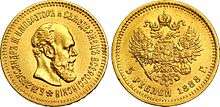
The Russian famine of 1891–92, which caused 375,000 to 500,000 deaths, and the ensuing cholera epidemic permitted some liberal activity, as the Russian government could not cope with the crisis and had to allow zemstvos to help with relief (among others, Leo Tolstoy helped organize soup-kitchens, and Chekhov directed anti-cholera precautions in several villages).
Alexander's political ideal was a nation composed of a single nationality, language, and religion, all under one form of administration. Through the teaching of the Russian language in Russian schools in Germany, Poland, and Finland, the destruction of the remnants of German, Polish, and Swedish institutions in the respective provinces, and the patronization of Eastern Orthodoxy, he attempted to realize this ideal.[12]
Alexander was hostile to Jews; His reign witnessed a sharp deterioration in the Jews' economic, social, and political condition. His policy was eagerly implemented by tsarist officials in the "May Laws" of 1882.[13] They banned Jews from inhabiting rural areas and shtetls (even within the Pale of Settlement) and restricted the occupations in which they could engage.[14][15]
Encouraged by its successful assassination of Alexander II, the Narodnaya Volya movement began planning the murder of Alexander III. The Okhrana uncovered the plot and five of the conspirators, including Alexander Ulyanov, the older brother of Vladimir Lenin, were captured and hanged in May 1887.
Foreign policy

The general negative consensus about the tsar's foreign policy follows the conclusions of the British Prime Minister Lord Salisbury in 1885:
- It is very difficult to come to any satisfactory conclusion as to the real objects of Russian policy. I am more inclined to believe there are none; that the Emperor is really his own Minister, and so bad a Minister that no consequent or coherent policy is pursued; but that each influential person, military or civil, snatches from him as opportunity offers the decisions which such person at the moment wants and that the mutual effect of these decisions on each other is determined almost exclusively by chance.[16][17]
In foreign affairs Alexander III was a man of peace, but not at any price, and held that the best means of averting war is to be well-prepared for it. Diplomat Nikolay Girs, scion of a rich and powerful family, served as his Foreign Minister from 1882 to 1895 and established the peaceful policies for which Alexander has been given credit. Girs was an architect of the Franco-Russian Alliance of 1891, which was later expanded into the Triple Entente with the addition of Great Britain. That alliance brought France out of diplomatic isolation, and moved Russia from the German orbit to a coalition with France, one that was strongly supported by French financial assistance to Russia's economic modernization. Girs was in charge of a diplomacy that featured numerous negotiated settlements, treaties and conventions. These agreements defined Russian boundaries and restored equilibrium to dangerously unstable situations. The most dramatic success came in 1885, settling long-standing tensions with Great Britain, which was fearful that Russian expansion to the South would be a threat to India.[18] Girs was usually successful in restraining the aggressive inclinations of Tsar Alexander convincing him that the very survival of the czarist system depended on avoiding major wars. With a deep insight into the tsar's moods and views, Girs was usually able to shape the final decisions by outmaneuvering hostile journalists, ministers, and even the czarina, as well as his own ambassadors. His Russia fought no wars.[19]
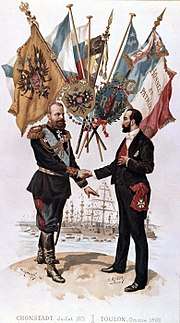
Though Alexander was indignant at the conduct of German chancellor Otto von Bismarck towards Russia, he avoided an open rupture with Germany—even reviving the League of Three Emperors for a period of time and in 1887, signed the Reinsurance Treaty with the Germans. However, in 1890, the expiration of the treaty coincided with the dismissal of Bismarck by the new German emperor, Kaiser Wilhelm II (for whom the Tsar had an immense dislike), and the unwillingness of Wilhelm II's government to renew the treaty. In response Alexander III then began cordial relations with France, eventually entering into an alliance with the French in 1892.[20]
Despite chilly relations with Berlin, the Tsar nevertheless confined himself to keeping a large number of troops near the German frontier. With regard to Bulgaria he exercised similar self-control. The efforts of Prince Alexander and afterwards of Stambolov to destroy Russian influence in the principality roused his indignation, but he vetoed all proposals to intervene by force of arms.[21]
In Central Asian affairs he followed the traditional policy of gradually extending Russian domination without provoking conflict with the United Kingdom (see Panjdeh Incident), and he never allowed the bellicose partisans of a forward policy to get out of hand. His reign cannot be regarded as an eventful period of Russian history; but under his hard rule the country made considerable progress.[22]
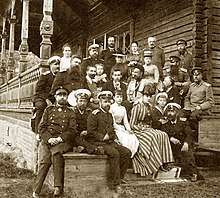
Alexander and his wife regularly spent their summers at Langinkoski manor along the Kymi River near Kotka on the Finnish coast, where their children were immersed in a Scandinavian lifestyle of relative modesty.
Alexander rejected foreign influence, German influence in particular, thus the adoption of local national principles was deprecated in all spheres of official activity, with a view to realizing his ideal of a Russia homogeneous in language, administration and religion. These ideas conflicted with those of his father, who had German sympathies despite being a patriot; Alexander II often used the German language in his private relations, occasionally ridiculed the Slavophiles and based his foreign policy on the Prussian alliance.[4]

Some differences between father and son had first appeared during the Franco-Prussian War, when Alexander II supported the cabinet of Berlin while the Tsesarevich made no effort to conceal his sympathies for the French. These sentiments would resurface during 1875–1879, when the Eastern Question excited Russian society. At first the Tsesarevich was more Slavophile than the government, but his phlegmatic nature restrained him from many exaggerations, and any popular illusions he may have imbibed were dispelled by personal observation in Bulgaria, where he commanded the left wing of the invading army. Never consulted on political questions, Alexander confined himself to military duties and fulfilled them in a conscientious and unobtrusive manner. After many mistakes and disappointments, the army reached Constantinople and the Treaty of San Stefano was signed, but much that had been obtained by that important document had to be sacrificed at the Congress of Berlin.[4]
Bismarck failed to do what was expected of him by the Russian emperor. In return for the Russian support which had enabled him to create the German Empire,[23] it was thought that he would help Russia to solve the Eastern question in accordance with Russian interests, but to the surprise and indignation of the cabinet of Saint Petersburg he confined himself to acting the part of "honest broker" at the Congress, and shortly afterwards contracted an alliance with Austria-Hungary for the purpose of counteracting Russian designs in Eastern Europe.[4]
The Tsesarevich could refer to these results as confirmation of the views he had expressed during the Franco-Prussian War; he concluded that for Russia, the best thing was to recover as quickly as possible from her temporary exhaustion, and prepare for future contingencies by military and naval reorganization. In accordance with this conviction, he suggested that certain reforms should be introduced.[4]
Trade and Industry
Alexander III took initiatives to stimulate the development of trade and industry, as his father did before him. Russia's economy was still challenged by the Russian-Turkish war of 1877-1878, which created a deficit, so he imposed customs duties on imported goods. To further alleviate the budget deficit, he implemented increased frugality and accounting in state finances. Industrial development increased during his reign.[24] Also during his reign, construction of the Trans Siberian Railway was started.[25]
Family life
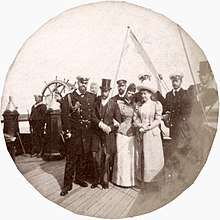
Following his father's assassination, Alexander III was advised that it would be difficult for him to be kept safe at the Winter Palace. As a result, Alexander relocated his family to the Gatchina Palace, located 30 kilometres (20 mi) south of St. Petersburg, making it his primary residence. Under heavy guard he would make occasional visits into St. Petersburg, but even then he would stay in the Anichkov Palace, as opposed to the Winter Palace.
In the 1860s Alexander fell madly in love with his mother's lady-in-waiting, Princess Maria Elimovna Meshcherskaya. Dismayed to learn that Prince Wittgenstein had proposed to her in early 1866, he told his parents that he was prepared to give up his rights of succession in order to marry his beloved "Dusenka". On 19 May 1866, Alexander II informed his son that Russia had come to an agreement with the parents of Princess Dagmar of Denmark, his fourth cousin. Before then, she had been the fiancée of his late elder brother Nicholas. At first Alexander refused to travel to Copenhagen, declaring that he did not love Dagmar and wanted to marry Maria. In response the enraged emperor ordered Alexander to go straight to Denmark and propose to Princess Dagmar. The Tsesarevich then realised that he was not a free man and that duty had to come first and foremost; the only thing left to do was to write in his diary "Farewell, dear Dusenka." Maria was forced to leave Russia, accompanied by her aunt, Princess Chernyshova. Almost a year after her first appearance in Paris, Pavel Pavlovich Demidov, 2nd Prince di San Donato, fell in love with her and the couple married in 1867. Maria would die giving birth to her son Elim Pavlovich Demidov, 3rd Prince di San Donato.
Alexander soon grew fond of Dagmar and had six children by her, five of whom survived into adulthood: Nicholas (b. 1868), George (b. 1871), Xenia (b. 1875), Michael (b. 1878) and Olga (b. 1882). Of his five surviving children, he was closest to his youngest two. In 1885 it was Alexander who commissioned Peter Carl Fabergé to produce the first of what were to become a series of jeweled Easter eggs (now called "Fabergé eggs") for her as an Easter gift, the First Hen egg, which delighted her immensely and became an annual Easter tradition for Alexander and, upon his succession, for his son Nicholas as well.
.jpg)
Each summer his parents-in-law, King Christian IX and Queen Louise, held family reunions at the Danish royal palaces of Fredensborg and Bernstorff, bringing Alexander, Maria and their children to Denmark.[26] His sister-in-law, the Princess of Wales, would come from Great Britain with some of her children, and his brother-in-law, King George I of Greece, his wife, Queen Olga, who was a first cousin of Alexander and a Romanov Grand Duchess by birth, came with their children from Athens.[26] In contrast to the strict security observed in Russia, Alexander and Maria revelled in the relative freedom that they enjoyed in Denmark, Alexander once commenting to the Prince and Princess of Wales near the end of a visit that he envied them being able to return to a happy home in England, while he was returning to his Russian prison.[27] In Denmark, he was able to enjoy joining his children in muddy ponds looking for tadpoles, sneaking into his father-in-law's orchard to steal apples, and playing pranks, such as turning a water hose on the visiting King Oscar II of Sweden.[27]
As Tsesarevich—and then as Tsar—Alexander had an extremely poor relationship with his brother Grand Duke Vladimir. This tension was reflected in the rivalry between Maria Feodorovna and Vladimir's wife, Grand Duchess Marie Pavlovna.[28] Alexander had better relationships with his other brothers: Alexei (whom he made rear admiral and then a grand admiral of the Russian Navy), Sergei (whom he made governor of Moscow) and Paul.
Despite the antipathy that Alexander had towards his stepmother, Princess Catherine Dolgorukov, he nevertheless allowed her to remain in the Winter Palace for some time after his father's assassination and to retain various keepsakes of him. These included Alexander II's blood-soaked uniform that he died wearing, and his reading glasses.[29]
On 29 October [O.S. 17 October] 1888 the Imperial train derailed in an accident at Borki. At the moment of the crash, the imperial family was in the dining car. Its roof collapsed, and Alexander held its remains on his shoulders as the children fled outdoors. The onset of Alexander's kidney failure was later attributed to the blunt trauma suffered in this incident.[30]
Illness and death
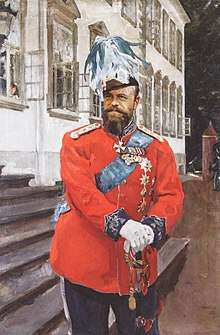
In 1894, Alexander III became ill with terminal kidney disease (nephritis). Maria Fyodorovna's sister-in-law, Queen Olga of Greece, offered her villa of Mon Repos, on the island of Corfu, in the hope that it might improve the Tsar's condition.[31] By the time that they reached Crimea, they stayed at the Maly Palace in Livadia, as Alexander was too weak to travel any farther.[32] Recognizing that the Tsar's days were numbered, various imperial relatives began to descend on Livadia. Even the famed clergyman John of Kronstadt paid a visit and administered Communion to the Tsar.[33] On 21 October, Alexander received Nicholas's fiancée, Princess Alix, who had come from her native Darmstadt to receive the Tsar's blessing.[34] Despite being exceedingly weak, Alexander insisted on receiving Alix in full dress uniform, an event that left him exhausted.[35] Soon after, his health began to deteriorate more rapidly. He died in the arms of his wife, and in the presence of his physician, Ernst Viktor von Leyden, at Maly Palace in Livadia on the afternoon of 1 November [O.S. 20 October] 1894 at the age of forty-nine, and was succeeded by his eldest son Tsesarevich Nicholas, who took the throne as Nicholas II. After leaving Livadia on 6 November and traveling to St. Petersburg by way of Moscow, his remains were interred on 18 November at the Peter and Paul Fortress.
Monuments
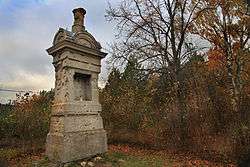
In 1909, a bronze equestrian statue of Alexander III sculpted by Paolo Troubetzkoy was placed in Znamenskaya Square in front of the Moscow Rail Terminal in St. Petersburg. Both the horse and rider were sculpted in massive form, leading to the nickname of "hippopotamus". Troubetzkoy envisioned the statue as a caricature, jesting that he wished "to portray an animal atop another animal", and it was quite controversial at the time, with many, including the members of the Imperial Family, opposed to the design, but it was approved because the Empress Dowager unexpectedly liked the monument. Following the Revolution of 1917 the statue remained in place as a symbol of tsarist autocracy until 1937 when it was placed in storage. In 1994 it was again put on public display, in front of the Marble Palace.[36] Another memorial is located in the city of Irkutsk at the Angara embankment.
On 18 November 2017, Vladimir Putin unveiled a bronze monument to Alexander III on the site of the former Maly Livadia Palace in Crimea. The four-meter monument by Russian sculptor Andrey Kovalchuk depicts Alexander III sitting on a stump, his stretched arms resting on a sabre. An inscription repeats his alleged saying "Russia has only two allies: the Army and the Navy."[37]
Titles, styles, honours and arms
| Styles of Alexander III of Russia | |
|---|---|
 | |
| Reference style | His Imperial Majesty |
| Spoken style | Your Imperial Majesty |
Titles and styles
- 10 March 1845 – 2 March 1865: His Imperial Highness Grand Duke Alexander Alexandrovich of Russia
- 2 March 1865 – 13 March 1881: His Imperial Highness The Tsesarevich of Russia
- 13 March 1881 – 1 November 1894: His Imperial Majesty The Emperor and Autocrat of All the Russias
Honours
- Domestic[38]
- Knight of St. Andrew, 10 March 1845
- Knight of St. Alexander Nevsky, 10 March 1845
- Knight of St. Anna, 1st Class, 10 March 1845
- Knight of the White Eagle, 10 March 1845
- Knight of St. Vladimir, 4th Class, 1864; 3rd Class, 1870
- Knight of St. Stanislaus, 1st Class, 1865
- Knight of St. George, 2nd Class, 1877
- Foreign[38]
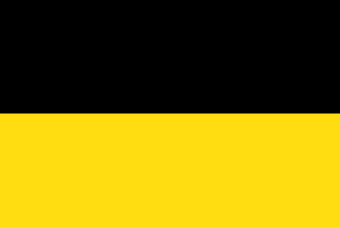
.svg.png)
.svg.png)
.svg.png)
.svg.png)
- Grand Cross of the Southern Cross, 14 January 1866
- Grand Cross of the Order of Pedro I, 15 September 1868


- Knight of the Elephant, 29 June 1865
- Cross of Honour of the Order of the Dannebrog, 3 July 1866
- Grand Commander of the Dannebrog, 9 November 1891
- Commemorative Medal for the Golden Wedding of King Christian IX and Queen Louise, 1892
.svg.png)
.svg.png)
.svg.png)
.svg.png)
.svg.png)
.svg.png)
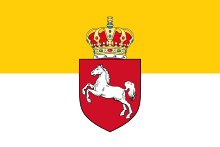
- Knight of St. George, 1865
- Grand Cross of the Royal Guelphic Order, 1865

_crowned.svg.png)
.svg.png)
.svg.png)
- Grand Cordon of the Rising Sun, 28 August 1879
- Grand Cordon of the Order of the Chrysanthemum, 20 May 1880[50]

- Grand Cross of the Wendish Crown, with Crown in Ore, 1865[51]
- Cross for Distinction in War (Strelitz), 3 December 1877
.svg.png)
.svg.png)

- Grand Cross of the Netherlands Lion, 19 May 1865
- Grand Cross of the Military William Order, 17 March 1881[52]

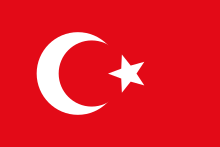
- Order of Osmanieh, 1st Class, 1 April 1866
- Order of Distinction, 3 December 1884
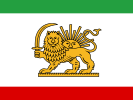
.svg.png)
- Knight of the Black Eagle, 27 July 1857[54]
- Pour le Mérite (military), 16 December 1877[55]
.svg.png)
- Grand Cross of the Tower and Sword, 22 June 1865
- Grand Cross of the Sash of the Two Orders, 1 May 1873; Three Orders, 25 May 1881

- Grand Cross of the Star of Romania, 15 November 1877
- Military Virtue Medal, 17 January 1878
- Crossing of the Danube Cross (military), 10 May 1879
.svg.png)
.svg.png)
.svg.png)
- Grand Cross of the Cross of Takovo, 26 March 1878
- Bronze Commemorative Medal for the Russo-Turkish War, 17 April 1878
- Grand Cross of the White Eagle, 29 April 1883
.svg.png)
.svg.png)
.svg.png)

- Knight of the Seraphim, 2 June 1865[60]
- Grand Cross of St. Olav, 25 August 1879[61]

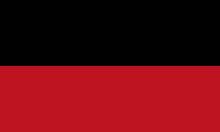
Arms
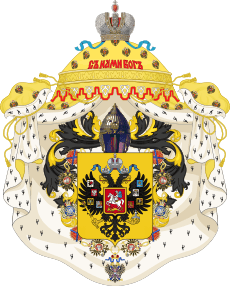
Issue

Alexander III had six children (five of whom survived to adulthood) of his marriage with Princess Dagmar of Denmark, also known as Marie Feodorovna.
(Note: all dates prior to 1918 are in the Old Style Calendar)
| Name | Birth | Death | Notes |
|---|---|---|---|
| Emperor Nicholas II of Russia | 18 May 1868 | 17 July 1918 | married 26 November 1894, Princess Alix of Hesse (1872–1918); had five children |
| Grand Duke Alexander Alexandrovich of Russia | 7 June 1869 | 2 May 1870 | died of meningitis, aged 10 months and 26 days |
| Grand Duke George Alexandrovich of Russia | 9 May 1871 | 9 August 1899 | died of tuberculosis, aged 28; had no issue |
| Grand Duchess Xenia Alexandrovna of Russia | 6 April 1875 | 20 April 1960 | married 6 August 1894, Grand Duke Alexander Mikhailovich of Russia (1866–1933); 11 Sep April 1919; had seven children |
| Grand Duke Michael Alexandrovich of Russia | 4 December 1878 | 13 June 1918 | married 16 October 1912, Natalia Sergeyevna Wulfert (1880–1952); had one child |
| Grand Duchess Olga Alexandrovna of Russia | 13 June 1882 | 24 November 1960 | married 9 August 1901, Duke Peter Alexandrovich of Oldenburg (1868–1924); div. 16 October 1916; had no issue.
married 16 November 1916, Colonel Nikolai Kulikovsky (1881–1958); had two children |
Ancestors
| Ancestors of Alexander III of Russia |
|---|
See also
- Tsars of Russia family tree
References
- 10 March [O.S. 26 February] 1845 – 1 November [O.S. 20 October] 1894
- 13 March [O.S. 1 March] 1881 – 1 November [O.S. 20 October] 1894.
- Wallace 1911, pp. 561-562.
- Wallace 1911, p. 562.
- Van Der Kiste, John The Romanovs: 1818–1959 (Sutton Publishing, 2003) p. 94
- "ALEXANDER III., ALEXANDROVICH, Emperor of Russia - JewishEncyclopedia.com". www.jewishencyclopedia.com.
- "Die Judenverfolgung in Rußland in der Krönungswoche" (in German), Das interessante Blatt, 7 June 1883.
- "Rioting and Politics in Russia", The New York Times, 1 June 1883.
- "YIVO - Pogroms". www.yivoencyclopedia.org.
- Sebag Montefiore, p. 668
- "Alexander III (1881-94)". Global Security.
- Florinsky, Michael T. (6 March 2019). "Alexander III". Encyclopædia Brittanica. Encyclopædia Britannica, inc. Retrieved 5 September 2019.
- I. Michael Aronson, "The Attitudes of Russian Officials in the 1880s toward Jewish Assimilation and Emigration." Slavic Review 34.1 (1975): 1-18. online
- "This day, May 15, in Jewish history". Cleveland Jewish News.
- I. Michael Aronson, "The Prospects for the Emancipation of Russian Jewry during the 1880s." Slavonic and East European Review (1977): 348-369. online
- Margaret Maxwell, "A Re-examination of the Role of N. K. Giers as Russian Foreign Minister under Alexander III" pp 352–53.
- S. C. M. Paine (1996). Imperial Rivals: China, Russia, and Their Disputed Frontier. M.E. Sharpe. p. 248. ISBN 9781563247248.
- Raymond A. Mohl, "Confrontation in Central Asia, 1885," History Today (1969) 119#3 pp. 176–183.
- Margaret Maxwell, "A Re-examination of the Rôle of N.K. Giers as Russian Foreign Minister under Alexander III." European Studies Review 1.4 (1971): 351-376.
- Van Der Kiste, John The Romanovs: 1818–1959 (Sutton Publishing; 2003) p. 162
- Charles Jelavich, "Russo-Bulgarian relations, 1892-1896: with particular reference to the problem of the bulgarian succession." Journal of Modern History 24.4 (1952): 341-351. Online
- Wallace 1911, p. 563.
- Baynes, Thomas Spencer (1902). The Encyclopaedia Britannica: A Dictionary of Arts, Sciences, and General Literature. Little, Brown. p. 260.
- https://russia.rin.ru/guides_e/7022.html. Retrieved 14 August 2020. Missing or empty
|title=(help) - "The Trans-Siberian Railway". History Today.
- Van Der Kiste, John The Romanovs: 1818–1959 (Sutton Publishing, 2003), p. 151
- Van Der Kiste, p. 152
- Van Der Kiste, p. 141
- Van Der Kiste, p. 118
- Scott Malsom. "Diaries and Letters - Alexander III". Alexander Palace Time Machine. Retrieved 1 February 2018.
- King, Greg The Court of the Last Tsar: Pomp, Power and Pageantry in the Reign of Nicholas II (John Wiley & Sons, 2006) p. 325
- King, p. 325
- John Perry & Constantine Pleshakov The Flight of the Romanovs: a Family Saga (Basic Books, 1999) p. 62
- King, p. 326
- King, p. 327
- Figes, Orlando (1997). A People's Tragedy. p. 15. ISBN 0-7126-7327-X.
- "Putin unveils monument to Russia's Tsar Alexander III in Crimea". TASS. 18 November 2017. Retrieved 19 November 2017.
- Russian Imperial Army - Emperor Alexander III of Russia (In Russian)
- "A Szent István Rend tagjai" Archived 22 December 2010 at the Wayback Machine
- Hof- und Staats-Handbuch des Großherzogtum Baden (1876), "Großherzogliche Orden" p. 58
- Bayern (1867). Hof- und Staatshandbuch des Königreichs Bayern: 1867. Landesamt. p. 10.
- "Knights of the Order of Bravery" (in Bulgarian).
- Bille-Hansen, A. C.; Holck, Harald, eds. (1894) [1st pub.:1801]. Statshaandbog for Kongeriget Danmark for Aaret 1894 [State Manual of the Kingdom of Denmark for the Year 1894] (PDF). Kongelig Dansk Hof- og Statskalender (in Danish). Copenhagen: J.H. Schultz A.-S. Universitetsbogtrykkeri. p. 3, 6. Retrieved 16 September 2019 – via da:DIS Danmark.
- Staatshandbücher für das Herzogtum Sachsen-Coburg und Gotha (1890), "Herzogliche Sachsen-Ernestinischer Hausorden" p. 46
- M. & B. Wattel. (2009). Les Grand'Croix de la Légion d'honneur de 1805 à nos jours. Titulaires français et étrangers. Paris: Archives & Culture. p. 516. ISBN 978-2-35077-135-9.
- Kalakaua to his sister, 12 July 1881, quoted in Greer, Richard A. (editor, 1967) "The Royal Tourist—Kalakaua's Letters Home from Tokio to London", Hawaiian Journal of History, vol. 5, p. 96
- Staat Hannover (1865). Hof- und Staatshandbuch für das Königreich Hannover: 1865. Berenberg. pp. 38, 81.
- Hof- und Staats-Handbuch des Großherzogtum Hessen (1879), "Großherzogliche Orden und Ehrenzeichen" p. 11
- Calendario reale per l'anno 1887, Vincenzo Bona, Torino, 1886, p. 136.
- 刑部芳則 (2017). 明治時代の勲章外交儀礼 (PDF) (in Japanese). 明治聖徳記念学会紀要. p. 143.
- Daniel Corston. "Unofficial website dedicated to the Grand Ducal House of Mecklenburg-Strelitz". mecklenburg-strelitz.org.
- "Militaire Willems-Orde: Romanov, Aleksandr III Nikolajevitsj" [Military William Order: Romanov, Alexander III Alexandrovich]. Ministerie van Defensie (in Dutch). 17 March 1881. Retrieved 12 March 2016.
- Staat Oldenburg (1873). Hof- und Staatshandbuch des Großherzogtums Oldenburg: für ... 1872/73. Schulze. p. 29.
- Justus Perthes, Almanach de Gotha (1894) p. 87
- Lehmann, Gustaf (1913). Die Ritter des Ordens pour le mérite 1812–1913 [The Knights of the Order of the Pour le Mérite] (in German). 2. Berlin: Ernst Siegfried Mittler & Sohn. p. 551.
- Bragança, Jose Vicente de; Estrela, Paulo Jorge (2017). "Troca de Decorações entre os Reis de Portugal e os Imperadores da Rússia" [Exchange of Decorations between the Kings of Portugal and the Emperors of Russia]. Pro Phalaris (in Portuguese). 16: 10. Retrieved 19 March 2020.
- Staatshandbuch für den Freistaat Sachsen (1867) (in German), "Königliche Ritter-Orden", p. 4
- Staatshandbuch für das Großherzogtum Sachsen / Sachsen-Weimar-Eisenach (1869), "Großherzogliche Hausorden" p. 12
- "Caballeros de la insigne orden del toisón de oro". Guía Oficial de España (in Spanish). 1887. p. 146. Retrieved 21 March 2019.
- Sveriges och Norges Statskalender (in Swedish), 1866, p. 435, retrieved 20 February 2019 – via runeberg.org
- Norges Statskalender (in Norwegian), 1890, p. 595, retrieved 6 January 2018 – via runeberg.org
- Shaw, Wm. A. (1906) The Knights of England, I, London, p. 66
- Württemberg (1866). Hof- und Staats-Handbuch des Königreichs Württemberg: 1866. p. 31.

Bibliography
- Dorpalen, Andreas. "Tsar Alexander III and the Boulanger Crisis in France." Journal of Modern History 23.2 (1951): 122–136. online
- Etty, John. "Alexander III, Tsar of Russia 1881-1889." History Review 60 (2008): 1–5. online
- Hutchinson, John F. Late Imperial Russia: 1890–1917
- Lincoln, W. Bruce. The Romanovs : autocrats of all the Russias (1981) online free to borrow
- Lowe, Charles. Alexander III of Russia (1895) online free full-length old biography
- Nelipa, M., ALEXANDER III His Life and Reign (2014), Gilbert's Books
- Polunov, A. Iu. "Konstantin Petrovich Pobedonostsev—Man and Politician". Russian Studies in History 39.4 (2001): 8-32. online, by a leading scholar
- Polunov, A. Iu. "The Orthodox Church in the Baltic Region and the Policies of Alexander Ill's Government." Russian Studies in History 39.4 (2001): 66–76. online
- Suny, Ronald Grigor. "Rehabilitating Tsarism: The Imperial Russian State and Its Historians. A Review Article" Comparative Studies in Society and History 31#1 (1989) pp. 168–179 online
- Thomson, Oliver. Romanovs: Europe's Most Obsessive Dynasty (2008) ch 13
- Whelan, Heide W. Alexander III & the State Council: bureaucracy & counter-reform in late imperial Russia (Rutgers UP, 1982).
External links
| Wikimedia Commons has media related to Alexander III of Russia. |
- Alexander III. Historical photos.
- A short biography
- Romanovs. The eighth film. Alexander III; Nicholas II. on YouTube – Historical reconstruction "The Romanovs". StarMedia. Babich-Design(Russia, 2013)
Alexander III of Russia Cadet branch of the House of Oldenburg Born: 10 March 1845 Died: 1 November 1894 | ||
| Regnal titles | ||
|---|---|---|
| Preceded by Alexander II |
Emperor of Russia Grand Duke of Finland 1881–1894 |
Succeeded by Nicholas II |
.svg.png)
.svg.png)
